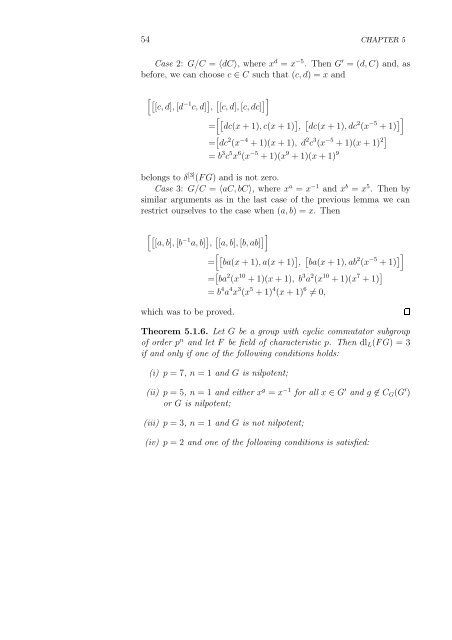On the Derived Length of Lie Solvable Group Algebras
On the Derived Length of Lie Solvable Group Algebras
On the Derived Length of Lie Solvable Group Algebras
You also want an ePaper? Increase the reach of your titles
YUMPU automatically turns print PDFs into web optimized ePapers that Google loves.
54 CHAPTER 5<br />
Case 2: G/C = 〈dC〉, where x d = x −5 . Then G ′ = (d, C) and, as<br />
before, we can choose c ∈ C such that (c, d) = x and<br />
[c, d], [d −1 c, d] , [c, d], [c, dc] <br />
dc(x <br />
2 −5<br />
= + 1), c(x + 1) , dc(x + 1), dc (x + 1) <br />
= dc 2 (x −4 + 1)(x + 1), d 2 c 3 (x −5 + 1)(x + 1) 2<br />
= b 3 c 5 x 6 (x −5 + 1)(x 9 + 1)(x + 1) 9<br />
belongs to δ [3] (F G) and is not zero.<br />
Case 3: G/C = 〈aC, bC〉, where x a = x −1 and x b = x 5 . Then by<br />
similar arguments as in <strong>the</strong> last case <strong>of</strong> <strong>the</strong> previous lemma we can<br />
restrict ourselves to <strong>the</strong> case when (a, b) = x. Then<br />
[a, b], [b −1 a, b] , [a, b], [b, ab] <br />
which was to be proved.<br />
ba(x 2 −5<br />
= + 1), a(x + 1) , ba(x + 1), ab (x + 1) <br />
= ba 2 (x 10 + 1)(x + 1), b 3 a 2 (x 10 + 1)(x 7 + 1) <br />
= b 4 a 4 x 3 (x 5 + 1) 4 (x + 1) 6 = 0,<br />
Theorem 5.1.6. Let G be a group with cyclic commutator subgroup<br />
<strong>of</strong> order p n and let F be field <strong>of</strong> characteristic p. Then dlL(F G) = 3<br />
if and only if one <strong>of</strong> <strong>the</strong> following conditions holds:<br />
(i) p = 7, n = 1 and G is nilpotent;<br />
(ii) p = 5, n = 1 and ei<strong>the</strong>r x g = x −1 for all x ∈ G ′ and g ∈ CG(G ′ )<br />
or G is nilpotent;<br />
(iii) p = 3, n = 1 and G is not nilpotent;<br />
(iv) p = 2 and one <strong>of</strong> <strong>the</strong> following conditions is satisfied:


